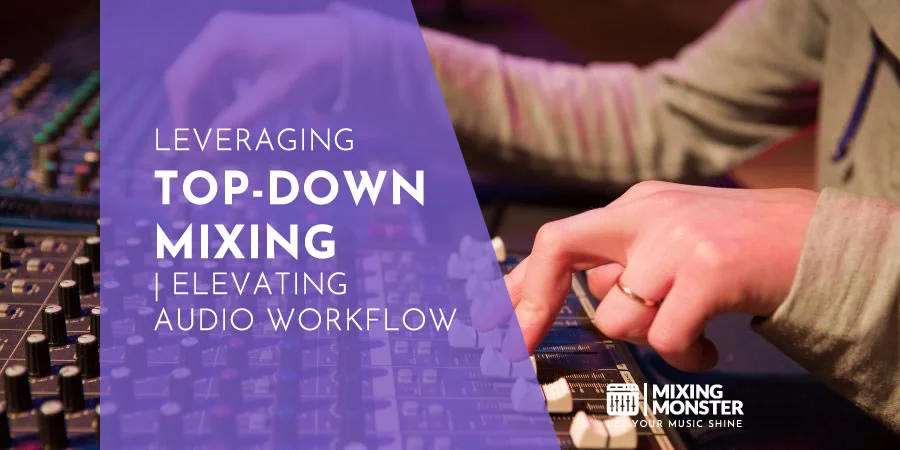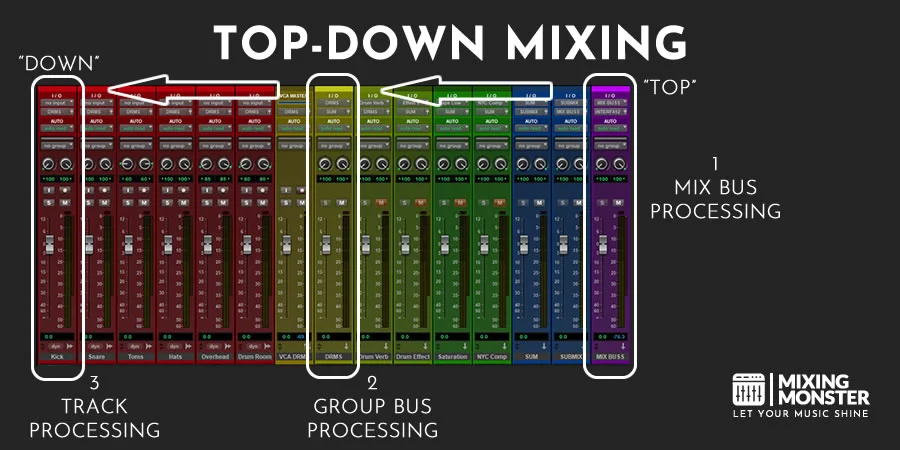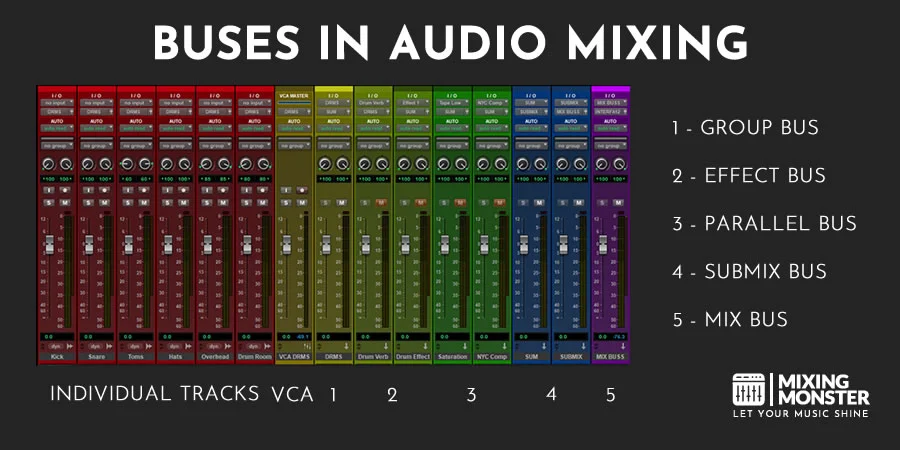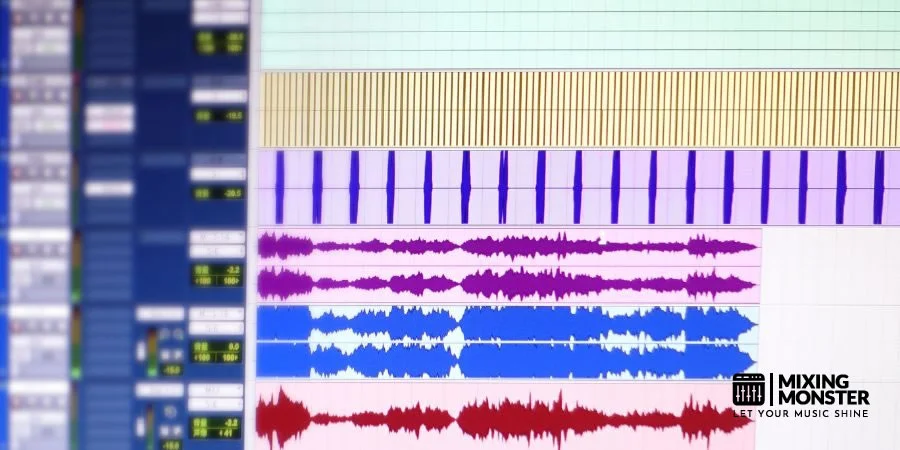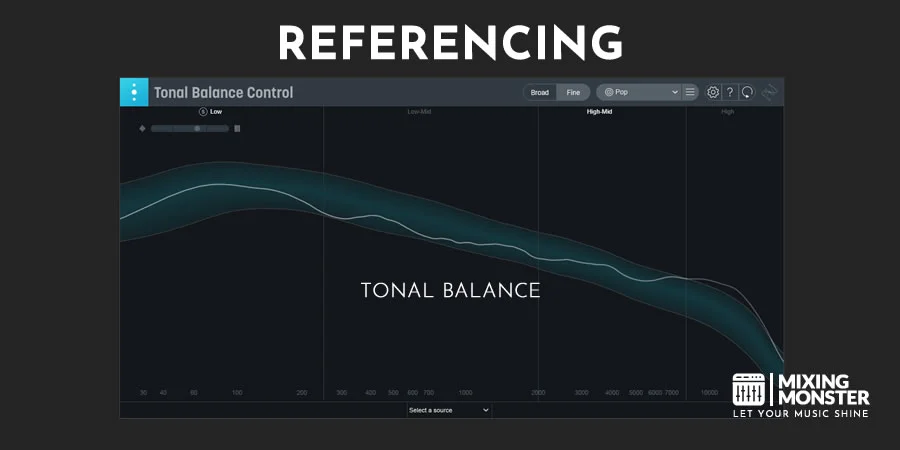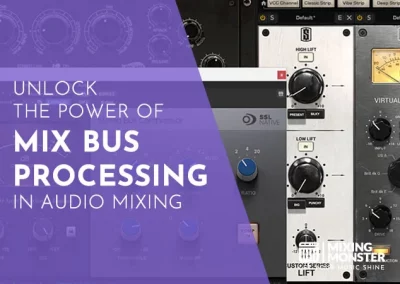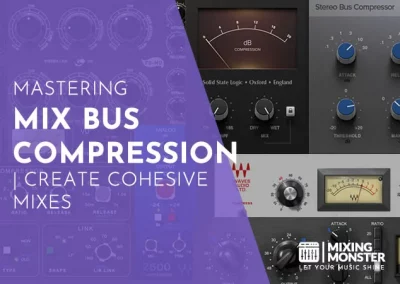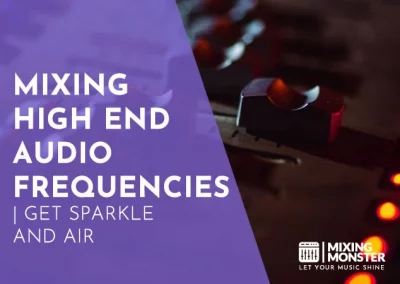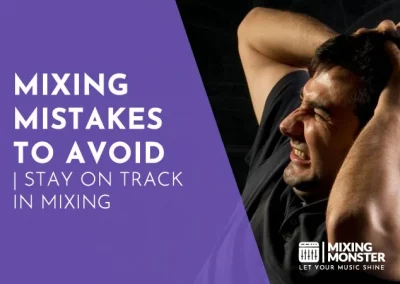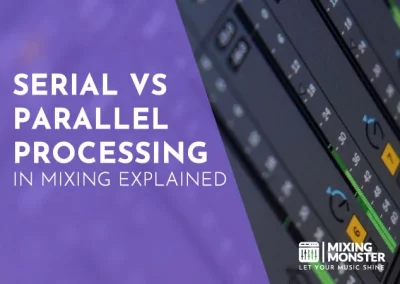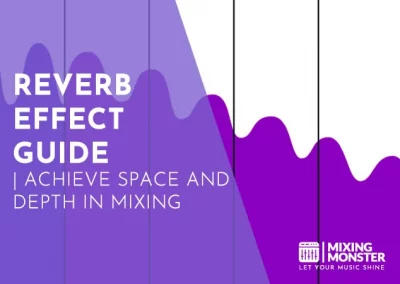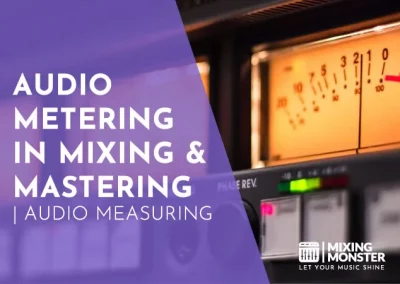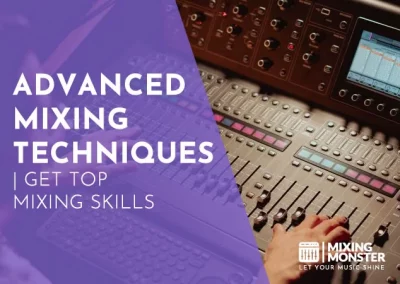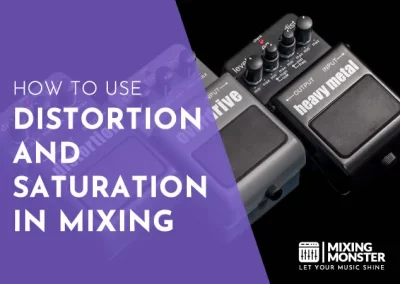Home > Blog > Mixing > Mixing Techniques
The top-down mixing method has revolutionized the way audio engineers approach the mixing process, offering a more efficient and balanced workflow. In this article, we’ll explore the fundamentals of top-down mixing and uncover how it can elevate your audio production to new heights.
The top-down method in audio mixing is a modern approach that prioritizes processing on the mix bus (stereo bus or master bus) before addressing individual tracks. It emphasizes overall mix balance and streamlines the mixing process, leading to greater efficiency and consistent, professional results.
Discover how the top-down method in audio mixing can transform your workflow, helping you achieve professional-sounding mixes with ease. Explore this fairly simple, yet impactful approach that’s changing the game for music producers and engineers alike.
Table Of Contents
1. The Top-Down Mixing Method Explained
2. Benefits Of Top-Down Mixing
3. Utilizing Buses In Top-Down Mixing
4. The Role Of The Mix Bus In Top-Down Mixing
5. Balancing Individual Tracks In Top-Down Mixing
6. Parallel Processing And Routing In Top-Down Mixing
7. Proper Monitoring And Referencing In Top-Down Mixing
8. Things To Avoid When Top-Down Mixing
9. Elevate Your Audio Workflow With Top-Down Mixing

1. The Top-Down Mixing Method Explained
The top-down mixing method is a technique in audio mixing where the focus is on processing the mix bus (also known as the stereo bus or master bus) before addressing individual tracks.
This approach prioritizes overall mix balance and cohesiveness, often resulting in faster workflow and more consistent mixes.
The process begins by applying EQ, compression, saturation, and maybe stereo imaging to the mix bus, shaping the overall sound and character of the mix up front.
In contrast, the bottom-up mixing method starts by working on individual tracks and gradually building the mix from the ground up.
This approach usually involves processing each track separately with EQ, compression, and other effects before moving on to the next one. The mix comes together as a sum of its parts, with each track being treated in isolation before being combined.
The main difference between the top-down and bottom-up methods lies in their focus and workflow.
The top-down method emphasizes the big picture, creating a cohesive mix by starting with the mix bus and working down to individual tracks.
The bottom-up method, on the other hand, starts with the details of each track and builds up the mix by layering and combining these elements.
Both approaches have their merits, but the top-down method often yields faster results and a more balanced mix, as it encourages engineers to consider the entire mix from the outset.
2. Benefits Of Top-Down Mixing
The top-down method in audio mixing has gained popularity due to its various advantages.
By focusing on the overall mix first, engineers can achieve a more balanced and cohesive sound while enjoying a more efficient workflow. Here are some key advantages of using the top-down method:
Benefits Of Top-Down Mixing:
- Faster Workflow:
Since the top-down method starts with processing the mix bus, it helps establish the overall tonal balance and character of the mix early in the process. This approach allows engineers to make broad, impactful adjustments before diving into individual tracks, ultimately reducing the time spent on fine-tuning and tweaking. - More Consistent Results:
By establishing the mix’s general sound from the outset, engineers can make more informed decisions when processing individual tracks. This holistic approach helps maintain consistency across the mix, as each track is adjusted with the context of the entire mix in mind. This consistency can lead to better translation across different playback systems. - Better Overall Mix Balance:
Top-down mixing emphasizes overall mix balance and cohesiveness. By focusing on the mix bus first, engineers can address frequency, dynamics, and stereo image issues that affect the entire mix before diving into individual tracks. This approach often results in a more natural and well-balanced mix, as tracks are adjusted with the overall sound already established. - Improved Decision-Making:
With the overall mix character set, engineers can make better decisions regarding individual track processing. This approach helps prevent overprocessing, as each track is adjusted with a clear understanding of its role within the mix. This can lead to cleaner, more dynamic mixes with greater clarity and separation. - Streamlined Processing:
Top-down mixing can reduce the need for excessive processing on individual tracks. By addressing the mix’s overall tonal balance and character first, engineers may find that fewer adjustments are needed on individual tracks, leading to a more efficient and less CPU-intensive mixing process.
The top-down method in audio mixing offers several advantages, including faster workflow, more consistent results, and better overall mix balance.
By focusing on the mix bus first and working down to individual tracks, engineers can achieve a more cohesive and polished sound while streamlining their mixing process.
3. Utilizing Buses In Top-Down Mixing
In the top-down method of audio mixing, the use of separate buses plays an essential role in creating a structured and organized mix.
Buses are used to group together and process similar tracks, making it easier to manage and control their overall sound. Here’s how separate buses can be utilized in top-down mixing:
Utilizing Buses In Top-Down Mixing:
- Group Buses:
Group similar tracks together, such as drums, guitars, vocals, or synths, and route them to their respective group buses. Apply processing like EQ, compression, and effects to these group buses to achieve a cohesive sound for each instrument group. This step enables you to shape the character of the grouped tracks before they reach the mix bus. - Submix Buses:
For more complex mixes or when working with multiple layers of similar instruments, create submix buses within group buses. For example, you might have a drum submix bus for kick and snare, and another for cymbals and percussion. This approach allows for even finer control over the elements within a group before they are combined and processed on the main group bus. - Parallel Buses:
Parallel processing is a popular technique in top-down mixing, where a duplicate signal is processed separately and then blended with the original signal. Create parallel buses for effects like compression, saturation, or reverb, and use them to enhance and add depth to your mix without altering the original tracks. Parallel buses can be created for individual tracks, group buses, or even the mix bus itself. - Effect Buses: Instead of applying effects directly to individual tracks or group buses, route them to dedicated effect buses (e.g., a reverb bus or a delay bus). By doing so, you can have better control over the amount and quality of the effects, and it also saves processing power by using a single instance of the effect for multiple tracks.
While using the top-down method in audio mixing, the primary focus remains on processing the mix bus, but separate buses help maintain a clean and organized workflow.
They enable you to manage the mix more effectively, simplify the processing chain, and ensure a more balanced and cohesive final product.
Let’s discuss the role of the mix bus in top-down mixing, which is your main “asset” while utilizing this method.
4. The Role Of The Mix Bus In Top-Down Mixing
The mix bus, also known as the stereo bus or master bus, is the final destination for all audio signals in a mixing project.
It is where all individual tracks and group buses are combined into a stereo mix, which is then typically sent to the mastering stage. The mix bus plays a crucial role in top-down mixing, as it helps shape the overall sound and character of the mix.
In top-down mixing, the mix bus is the primary focus, with processing applied to it before working on individual tracks or group buses.
By starting with the mix bus, engineers can address tonal balance, dynamics, and stereo image issues that affect the entire mix. This approach helps establish a cohesive sound early in the process, allowing for better decision-making when processing individual tracks.
Processing on the mix bus has a global effect on the entire mix, as any adjustments made at this stage will impact all the tracks combined within the mix. Common mix bus processing techniques include:
Common Mixbus Processing Techniques:
- EQ:
Equalization is used to shape the overall tonal balance of the mix, addressing any frequency imbalances or enhancing specific frequency ranges to achieve a desired sound. - Compression:
Mix bus compression is used to control the overall dynamics of the mix, providing a more consistent and polished sound. It helps glue the mix together, making it sound more cohesive and balanced. - Saturation:
Adding subtle saturation or harmonic distortion to the mix bus can enhance the overall warmth, character, and perceived loudness of the mix. - Stereo Imaging:
Adjusting the stereo width and depth on the mix bus helps create a more immersive and spacious soundstage, ensuring a balanced and engaging listening experience.
It’s essential to approach mix bus processing with caution, as overprocessing or making drastic adjustments can negatively impact the mix’s overall quality. The key is to use subtle adjustments to shape the mix’s character without compromising the integrity of individual tracks.
Processing on the mix bus affects the entire mix, making it essential to approach adjustments with care and subtlety to achieve a balanced and cohesive result.

5. Balancing Individual Tracks In Top-Down Mixing
Balancing individual tracks within the context of a top-down mix involves making adjustments to each track while considering the processing already applied on the mix bus.
This approach ensures that individual tracks contribute to the overall cohesion and balance of the mix. Let’s take a look at a basic workflow of processing a mix with applied top-down mixing. Here are some steps to balance individual tracks in the context of a top-down mix:
How To Balance Individual Tracks In Top-Down Mixing:
- Establish A Static Mix:
Before applying any processing to individual tracks, create a static mix by adjusting the level and panning of each track. This step involves setting the foundation of your mix, focusing on the volume balance between elements and the stereo placement of each track. - Analyze The Mix:
Listen to the mix and identify any issues or improvements needed on individual tracks. Consider how the mix bus processing affects each track and make a note of elements that may require additional attention, such as problematic frequencies, excessive dynamics, or lack of presence. - Process Individual Tracks:
Start working on individual tracks, keeping the mix bus processing in mind. Apply EQ, compression, and other effects as needed, but avoid over-processing to maintain the integrity of the mix. Remember that the mix bus processing has already shaped the overall character of the mix, so the goal is to make the individual tracks sit well within that context. - Address Masking And Frequency Conflicts:
Be mindful of frequency masking and conflicts between tracks. Use EQ to carve out space for each instrument, ensuring they have their place in the mix’s frequency spectrum. This step can help enhance the clarity and separation of individual elements. - Automation:
Use automation to make dynamic adjustments to the level, panning, or effects on individual tracks. Automation can help maintain a well-balanced mix by addressing changes in the arrangement or performance that may require additional attention. - Revisit The Mix Bus:
After working on individual tracks, revisit the mix bus processing to ensure it still complements the mix. Make any necessary adjustments to the mix bus settings based on how the individual tracks now sound within the mix. - Reference And Adjust:
Regularly reference your mix on different playback systems and compare it to professional tracks within the same genre. Make any necessary adjustments to the balance of individual tracks to ensure your mix translates well across various systems.
Balancing individual tracks within the context of a top-down mix requires careful consideration of the mix bus processing and its impact on the overall mix.
6. Parallel Processing And Routing In Top-Down Mixing
Parallel processing is a powerful technique in top-down mixing that involves processing a duplicate of a signal separately and blending it with the original, unprocessed signal.
This approach can be applied to individual tracks, group buses, or even the mix bus itself. Parallel processing maintains the dynamics of the original signal while adding depth, character, and impact to the mix.
Common parallel processing techniques in top-down mixing include parallel compression and parallel saturation.
Parallel Compression:
Also known as “New York compression” or “upward compression,” parallel compression involves creating a duplicate of a signal, applying heavy compression to the duplicate, and blending it with the original, uncompressed signal. This technique adds body and sustain to the sound while preserving the transients and dynamics of the original signal. Parallel compression is often used on drums, vocals, and the mix bus to add energy and presence to the mix without causing over-compression.
To set up parallel compression in top-down mixing:
- Create a duplicate bus or an auxiliary send from the desired track or bus.
- Insert a compressor on the duplicate bus or aux return.
- Apply heavy compression with a high ratio, fast attack, and fast to medium release.
- Blend the compressed signal with the original signal using the bus or aux return fader, adjusting to taste.
Parallel Saturation:
Parallel saturation involves adding harmonic distortion or saturation to a duplicate signal and blending it with the original. This technique can enhance the warmth, character, and perceived loudness of the mix without compromising the clarity and dynamics of the original signal.
To set up parallel saturation in top-down mixing:
- Create a duplicate bus or an auxiliary send from the desired track or bus.
- Insert a saturation or harmonic distortion plugin on the duplicate bus or aux return.
- Adjust the saturation plugin settings to achieve the desired amount of warmth and character.
- Blend the saturated signal with the original signal using the bus or aux return fader, adjusting to taste.
Parallel processing and routing in top-down mixing allow for creative control and flexibility while maintaining the dynamics and integrity of the original signal.
Parallel compression and parallel saturation can add depth, character, and impact to your mix, resulting in a more defined and professional sound.
7. Proper Monitoring And Referencing In Top-Down Mixing
Proper monitoring and referencing techniques are crucial in the top-down mixing method, as they directly impact the overall balance and character of the mix, which is established early in the process.
Since top-down mixing begins with mix bus processing, accurate monitoring is essential to make informed decisions about the mix’s overall tonal balance and dynamics. A well-tuned monitoring environment allows you to better understand how mix bus processing affects individual tracks and the mix as a whole.
Maintaining consistent listening levels is particularly important in top-down mixing, as this method relies on making incremental adjustments to individual tracks after establishing the overall mix balance. Consistent levels ensure that your perception of the mix remains reliable throughout the process.
The top-down method emphasizes the context of individual tracks within the overall mix. Accurate monitoring and referencing help maintain this context, ensuring that processing decisions on individual tracks complement the mix bus processing and contribute to a cohesive and polished final mix.
The top-down approach relies on achieving a balanced mix from the outset. Proper monitoring and referencing techniques help ensure that the mix translates well across various playback systems, minimizing the need for additional adjustments and ensuring a consistent listening experience.
Using reference tracks in the top-down mixing method provides valuable context for how your mix should sound in terms of overall balance, dynamics, and character. This context is especially important in top-down mixing, as the mix bus processing sets the stage for subsequent adjustments to individual tracks.
Proper monitoring and referencing techniques are vital in top-down mixing, as they directly influence the overall balance and character of the mix established early in the process.
8. Things To Avoid When Top-Down Mixing
When using the top-down mixing method, engineers may encounter certain pitfalls that can negatively impact the mix. Let’s take a look at some common mistakes and tips on how to avoid them:
- Overprocessing The Mix Bus:
Applying too much processing on the mix bus can lead to an over-processed sound, compromising the integrity of the mix.
How to avoid: Use mix bus processing judiciously and make subtle adjustments. Start with gentle EQ, mild compression, and light saturation, and always listen critically to ensure the processing enhances the mix without causing unwanted artifacts or excessive coloration.
- Neglecting Individual Tracks:
Focusing too much on the mix bus might result in neglecting the necessary processing on individual tracks, such as controlling dynamics, carving out space in the frequency spectrum, and adding depth and width.
How to avoid: After establishing the mix bus processing, pay attention to individual tracks, addressing any issues related to balance, dynamics, and frequency content. Ensure that each track complements the overall mix and contributes to a cohesive sound.
- Over-Reliance On Mix Bus Processing:
Relying solely on mix bus processing to fix issues that should be addressed at the individual track level can lead to an unbalanced and muddy mix.
How to avoid: Use mix bus processing to shape the overall character of the mix, but tackle specific issues like frequency masking, phase problems, or excessive dynamics at the individual track or group bus level.
- Inadequate Monitoring And Referencing:
Failing to use proper monitoring and referencing techniques can result in a mix that does not translate well across various playback systems.
How to avoid: Ensure your mixing environment is set up for accurate monitoring, maintain consistent listening levels, and regularly reference your mix on different systems. Use professional reference tracks to guide your mixing decisions and ensure your mix achieves the desired balance and character.
- Inconsistent Mixing Levels:
Mixing at varying loudness levels can lead to poor decisions regarding the balance and processing of individual tracks in the context of a top-down mix.
How to avoid: Monitor your mix at consistent, moderate levels to maintain a reliable perspective on the mix’s balance and dynamics. Take breaks to prevent ear fatigue and revisit your mix with a fresh perspective.
By being aware of these common mistakes and implementing the suggested strategies, you can make better decisions when using the top-down mixing method. Over time, you get a feel for the relationship between mix bus processing and the processing on individual tracks.
9. Elevate Your Audio Workflow With Top-Down Mixing
In conclusion, the top-down method in audio mixing offers a unique and efficient approach to achieving a polished and cohesive mix.
By focusing on the overall mix balance and character from the outset, engineers can create a strong foundation upon which to build and refine individual track elements.
By employing proper monitoring, referencing, and processing techniques, and by avoiding common pitfalls, the top-down method can lead to faster workflows and more consistent results.
Embracing this method can be a valuable addition to any audio engineer’s toolkit, providing an alternative perspective on the mixing process that emphasizes the importance of the mix as a whole.

